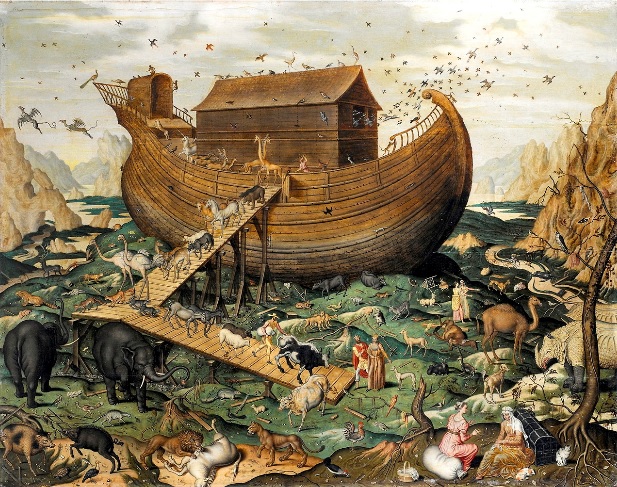I’ve noticed that few of my posts on this blog have related directly to the Bible, at least with Biblical quotations included (except regarding the “fiery flying serpent”). This may have been a major weakness in my writings, in particular for readers who had no previous experience with the writings and lectures of my associates, who sometimes make up for what I have lacked. I’ll take a step to correct that now, since the name of this blog is, after all, The Bible and Modern Pterosaurs.
I have never doubted the Biblical account of the Garden of Eden and the fall of mankind into the mortal condition in which we now live. I have also never doubted the reality of the Flood of Genesis, and that deserves attention here. Yet we need to take all of this in context: The Savior Jesus Christ accomplished the great atonement to save us from all the negative aspects of the Fall, a subject deserving a library of books. With that in mind, let’s now look at the Flood of Noah.
Genesis 7: 1-3 (King James Version)
And the Lord said unto Noah, Come thou and all thy house into the ark; for thee have I seen righteous before me in this generation.
Of every clean beast thou shalt take to thee by sevens, the male and his female: and of beasts that are not clean by two, the male and his female.
Of fowls also of the air by sevens, the male and the female; to keep seed alive upon the face of all the earth.
 Old depiction of the animals and birds leaving the Ark, but where are the dinosaurs?
Old depiction of the animals and birds leaving the Ark, but where are the dinosaurs?
Genesis actually gives us few details about the Ark and how eight humans and many creatures were saved by living on it for many months, at least few details compared with all that must have taken place. Let’s use a bit of human reasoning here, even though our limited abilities make the best of our reasoning inferior to what we can learn from the words of scripture.
Apparently even back in the time of Noah animals were divided into “clean” and “unclean,” meaning some were approved for human consumption and others were not. In the number of creatures to be taken into the Ark, a balance was necessary: predatory animals must be greatly outnumbered by the prey animals on which they would feed after the Flood was abated.
Regardless of what kind of animals Noah’s family ate (if any) before the Flood, and regardless of what they would eat afterwards, prey animals needed to be much more numerous than lions, eagles, and snakes, for example. Otherwise animals like deer, rabbits, and rats might become extinct, an event not completely tragic to all humans.
Details absent in Genesis
Did every variety of every type of creature enter the Ark of Noah? Why should they? Take the obvious example first: Would Noah have taken every breed of dog into the Ark, if all the present-day varieties existed in his day? No. Only a few genetically-healthy dogs would be needed, for they would have all the traits that could later become active in our modern breeds, even though the countless traits would not be outwardly visible in those original ancestors.
What about dinosaurs and pterosaurs? From eyewitness accounts over the centuries, at least some varieties of dinosaurs and pterosaurs must have been preserved on the Ark. For example, one of my associates, Brian Irwin of Australia, spoke with natives in the New Britain area of Papua New Guinea, and they described an encounter with an apparent Therizinosaurus. That is not to say that all types of dinosaurs were preserved from extinction in the Flood of Genesis, but not all of them became extinct.
Many eyewitness reports that I have received, over the past eleven years, suggest a narrow range of characteristics are common in modern pterosaurs. Many sighting reports include descriptions that include two or more of the following:
- Lack of feathers
- Long tail
- Flange (“diamond”) at tail end
- pointed horn-like head crest
The combination of a head crest and a Rhamphorhynchoid tail is uncommon in pterosaur fossils (but not totally absent from all types); yet that combination is common in eyewitness reports in the past 100 years. For some reason, long-tailed ropens (like Rhamphorhynchoids but sometimes much larger than fossils) may account for more than 60% of all modern pterosaurs, perhaps much more.
Do any of the recently-seen types closely relate to the “fiery flying serpents” of the Old Testament? Who knows? Yet with all of the wonderful possibilities, how much we need to learn by future discoveries, and how dearly we need the help of biologists in the search for these wonderful flying creatures!

Are these dragons flying away from the Ark of Noah? Apparently so.
###
.
What was the Fiery Flying Serpent?
Another problem with the snake interpretation strikes me to the heart. What is the usual symbolism here? Who does the snake usually represent in the Old and New Testament? Satan, of course. Does it seem likely that a true serpent would be used to symbolize Jesus Christ? If the “fiery flying serpent” were a snake, Moses would have killed one of them and dragged the dead snake on the ground, to symbolize God’s victory over Satan. He would not have given the Israelites the symbol for Satan, to look up to a common snake for healing or salvation.
Let us be Fair to the Young-Earth Creationist
For years I have worked with Young Earth Creationists in bringing to light evidence for modern living pterosaurs. For years critics have dismissed the possibility of live pterosaurs because the idea is promoted by YEC’s who believe in the Bible. This unfair approach, commonly accompanied by bulverism, now deserves attention.
For eleven years, I (Jonathan Whitcomb) have been a cryptozoologist, with a special interest in eyewitness accounts of flying creatures that look like pterosaurs, commonly called pterodactyls. I have given my opinions honestly about various levels of credibility in the individual reports that I have received from eyewitnesses . . .
The Ropen and the Fiery Flying Serpent
Rhamphorhynchoid pterosaurs are well known from fossils: long-tailed . . . If the fossils were really all we had to go by, members of the Rhamphorhynchoidea suborder would be consistantly small; but modern versions of those long-tailed pterosaurs can be almost any size, and that means a few are huge: bigger than fossils yet discovered.
.




2 Replies to “The Flood of Genesis”
Comments are closed.